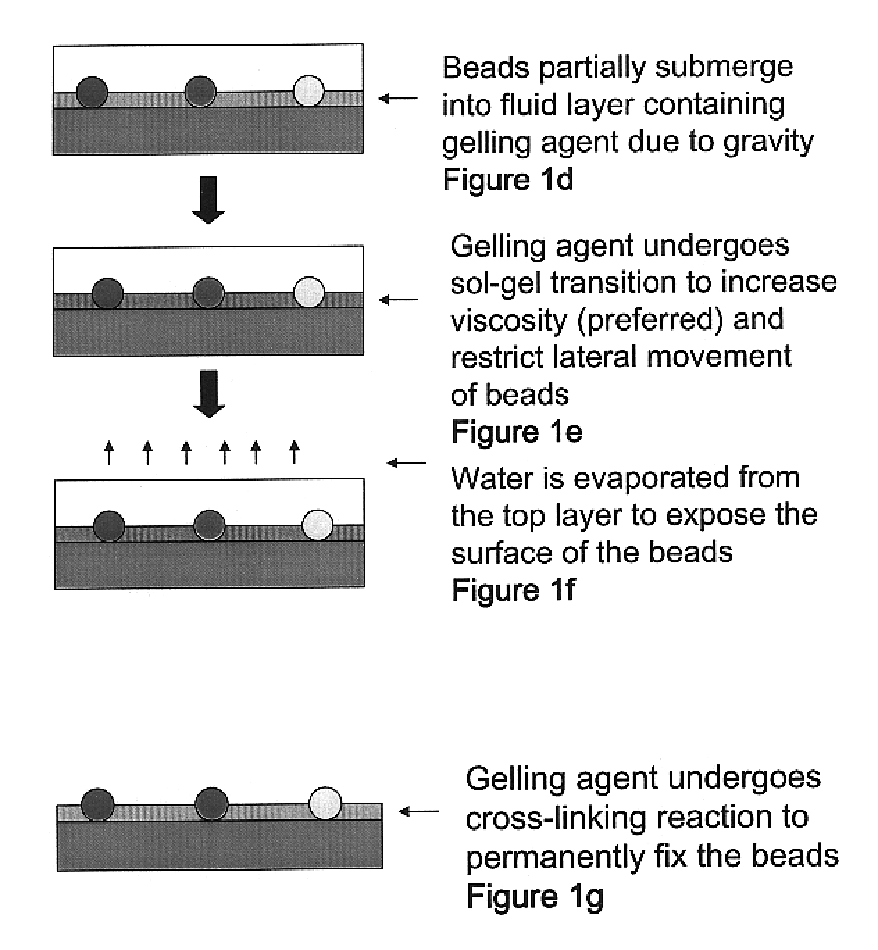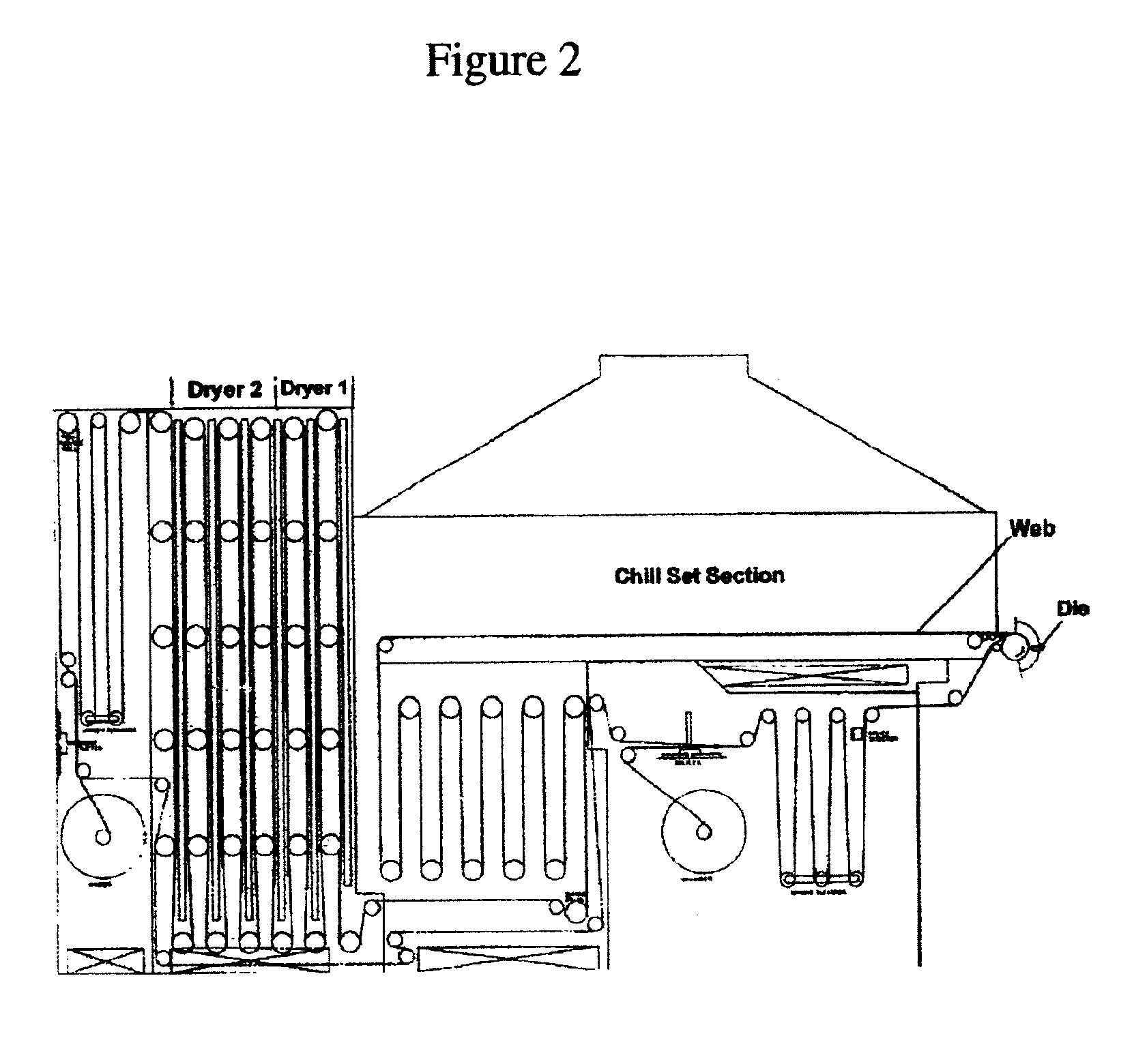Random array of microspheres
a random array and microsphere technology, applied in the field of biological microarray technology, can solve the problems of inability to accurately predict the exact the cost of the method, and the inability to accurately predict the size of the array, so as to facilitate the access of analyte, facilitate the preparation, and reduce the cost
- Summary
- Abstract
- Description
- Claims
- Application Information
AI Technical Summary
Benefits of technology
Problems solved by technology
Method used
Image
Examples
example 1 (
Control)
[0039]This and the following example illustrate the method of coating or fabricating a well-dispersed random array of microspheres wherein the surfaces of the micro-spheres are exposed above the surface of the receiving layer in which they are partially submerged.
[0040]Ten grams of a 4% aqueous suspension of carboxylated polystyrene beads prepared by emulsion polymerization and having a mean size of 10 microns was combined with 0.1 grams of poly(vinyl alcohol) (Gohsenol NK-05 from Nippon Gohsei; 71-75% hydrolyzed).
[0041]A suspension of magenta colored beads was prepared by first dissolving 0.01 grams of Dye 1 (MM2500EVV) in 0.05 grams of toluene and 4.95 grams of acetone. The above suspension of polystyrene beads was then added slowly (drop-wise) to this solution of the dye while stirring to prepare a suspension of colored beads. The suspension of colored beads was then filtered using a porous cotton filter, poured into a dialysis bag (12,000 to 14,000 molecular weight cut-o...
example 2 (
Invention)
[0048]This Example is the same as example 1, but characterized by the absence of gelling agent in the dispersion of microspheres.
[0049]Suspensions of magenta, cyan and yellow colored beads (containing Dye 1, Dye 2 and Dye 3 respectively) were prepared in a manner similar to that described under Example 1. In addition a suspension of purple colored beads containing Dye 4 was also prepared. The concentration of colored beads in these suspensions was close to 1% in all cases.
Formulations for coating were prepared as follows.
[0050]Receiving Layer: This was prepared in the same manner as described under Example 1.[0051]Dispersion of Microspheres: An aqueous composition with colored beads and no gelling agent was prepared by combining 1.5 grams of the suspension of magenta colored beads, 1.5 grams of the suspension of cyan colored beads and 1.5 grams of the suspension of yellow colored beads, 8 grams of the suspension of purple colored beads and 1.8 grams of clear non-colored be...
example 3
[0054]This example illustrates the effect of cross-linking the gelatin (gelling agent) in the sub-layer prior to coating the main layer.
[0055]Magenta, Cyan and Purple colored beads were prepared in a manner analogous to that described in Examples 1 and 2. The final concentrations of beads in these suspensions were 0.84%, 0.93% and 1.21% respectively.
Formulations for coating were prepared in the following manner.
[0056]Receiving Layer 1 (control): This was prepared by combining 87 grams of acid processed ossein gelatin (gelling agent), 50 grams of cross-linking agent for the gelatin (1.8% solution of bis(vinylsulfonyl)methane in water), 20 grams of coating aid (10.8% solution of Olin 10G in water) and 343 grams of distilled water.[0057]Receiving Layer 2 (invention): The composition was the same as that for receiving layer 1 except that it did not contain a cross-linking agent.[0058]Dispersion of Microspheres: This was prepared by combining 10.9 grams of the suspension of magenta color...
PUM
| Property | Measurement | Unit |
|---|---|---|
| mean diameter | aaaaa | aaaaa |
| mean diameter | aaaaa | aaaaa |
| diameter | aaaaa | aaaaa |
Abstract
Description
Claims
Application Information
 Login to View More
Login to View More - R&D
- Intellectual Property
- Life Sciences
- Materials
- Tech Scout
- Unparalleled Data Quality
- Higher Quality Content
- 60% Fewer Hallucinations
Browse by: Latest US Patents, China's latest patents, Technical Efficacy Thesaurus, Application Domain, Technology Topic, Popular Technical Reports.
© 2025 PatSnap. All rights reserved.Legal|Privacy policy|Modern Slavery Act Transparency Statement|Sitemap|About US| Contact US: help@patsnap.com



